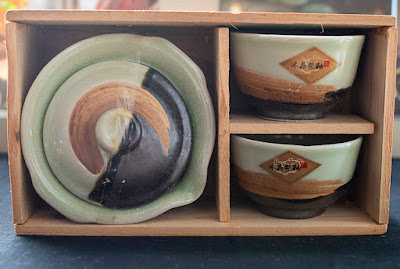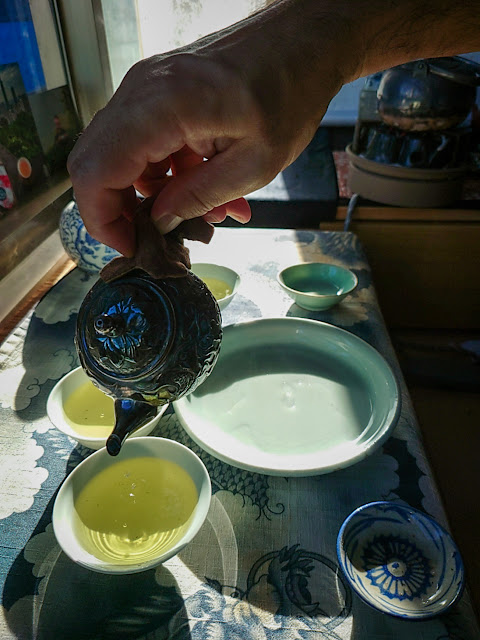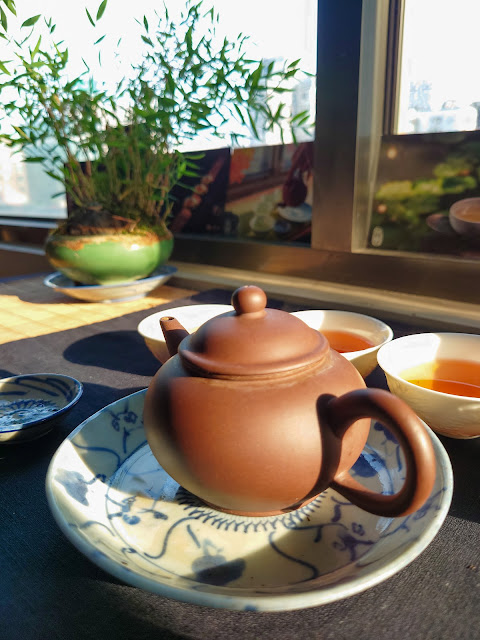3. For orders between 100 USD and 200 USD, you may choose
Wednesday, July 16, 2025
Tea happiness provider since July 2005
3. For orders between 100 USD and 200 USD, you may choose
Thursday, July 03, 2025
Spiritual-tea
Tuesday, July 01, 2025
Les boissons (et surtout le thé) dans Pot-Bouille d'Emile Zola
Pot-Bouille est un mot peu employé de nos jours, à moins qu'il s'agisse d'argot parisien. Il a la signification de tambouille, de cuisine accommodée et pratique où l'on cuit ce que l'on a sous la main. Zola l'emploi de manière imagée pour décrire les mœurs amoureuses et sexuelles de la bourgeoisie parisienne. Les relations extra-conjugales sont mal vues, mais elles sont courantes car faciles. Dans ce roman qui parle des relations hommes-femmes, il n'est pas étonnant que la boisson romantique et sociale par excellence, le thé, figure en bonne position avec 17 mentions! Mais la palme d'or revient au café (29 mentions) plus deux pour le 'café au lait'. En troisième place, nous avons le vin (13 mentions), le champagne (5 mentions) et le liqueurs (5 mentions). Grog et vinaigre ont 3 mentions. Ces boissons-ci ont 2 mentions: sirop de groseille, eau sucrée, cognac, bock, punch, vermouth. Puis, comme nous sommes à Paris, dans un milieu bourgeois, nous avons une grande variété de boissons avec une seule mention: absinthe, rhum, tilleul, bouillon, madère, verveine, johannisberg, pichon-longueville, roederer, sparling-moselle, kummel (alcool au cumin), chartreuse, cassis, eau-de-vie, bordeaux, crus. En tout, cela fait 59 boissons non alcoolisées et 47 alcools pour un total de 106 boissons. Dans les boissons non alcoolisées, il faut faire une place à part à un breuvage amer et symbolique qui concentre en lui tout le roman: la honte! Je vous renvoie à Nana où j'ai réalisé que Zola distille souvent le sujet principal de ses romans en une boisson symbolique.
Ici, c'est le cas au chapitre XII: "Enfin, on ne se faisait point garder un frère pareil, qui aurait réduit un mari à l'impuissance, même dans les cas de la plus légitime indignation, et jusqu'à le forcer à boire sa honte."
 |
| Oolong de Da Yu Ling |
Ainsi, la mère de Berthe fait ce reproche à sa fille adultère au chapitre XVI:
"- Devant Dieu! dit-elle, moi, je le jure que je me serais retenue, même si l'empereur m'avait tourmentée!... On y perd trop. (,,,) D'ailleurs, c'est la plus grande des hontes."
Cela n'empêche pas de nombreux personnages de coucher à droite et à gauche, mais ils respectent le onzième commandement (ils ne se font pas prendre) ou bien ils (les hommes) occupent une position sociale assez haute pour que la société ferme les yeux sur leurs agissements.
Mais revenons à notre boisson favorite et analysons les 17 mentions de thé dans cet ouvrage.
Il est la première boisson mentionnée au chapitre II: "Mais il ne fallait pas mettre la maison sur un pied supérieur à notre fortune. C'est votre maladie de recevoir et de rendre des visites, de prendre un jour, de donner du thé et des gâteaux..."
Mme Josserand rétorque à son mari: "Enfermez-moi tout de suite dans une boite. Reprochez-moi de ne pas sortir nue comme la main... Et vos filles, monsieur, qui épouseront-elles si elles ne voient personne."
Commentaire: Le thé est bien plus qu'une boisson. C'est un prétexte pour des relations sociales dont le but est de marier les jeunes filles.
Chapitre III: "Sans doute, son thé modeste ne valait pas leurs concerts à grand orchestre. Mais patience! quand ses deux filles seraient mariées, et qu'elle aurait deux gendres et leurs familles pour emplir son salon, elle aussi ferait chanter les cœurs."
Commentaire: La modestie de ce thé provient donc du faible nombre de convives et du manque de moyens déployés lors de la réception des invités.
Même chapitre: "- Maman, le thé est servi, dit Berthe, qui ouvrait avec Adèle les deux battants de la porte.
(...)
C'était, sur une nappe grise trop étroite, un de ces thés laborieusement servis, une brioche achetée chez un boulanger voisin, flanquée de petits fours et de sandwichs. Aux deux bouts, un luxe de fleurs, des roses superbes et coûteuses, couvraient la médiocrité du beurre et la poussière ancienne des biscuits. On se récria, des jalousies s'allumèrent : décidément, ces Josserand se coulaient pour marier leurs filles. Et les invités, avec des regards obliques vers les bosquets, se gorgèrent de thé aigre, tombèrent avec prudence sur les gâteaux rassis et la brioche mal cuite, ayant peu diné, ne songeant plus qu'à se coucher le ventre plein.
(...) Berthe s'empressait, offrant des sandwichs, portant des tasses de thé, demandant aux hommes s'ils voulaient qu'on les sucrât davantage.
(...) D'ailleurs, Octave dut lui paraitre froid, elle sentit que la coupe ne portait pas, elle se mit à l'épier d'un air d'inquiétude, pendant que Valérie et Mme Juzeur, qui en étaient à leur quatrième tasse de thé, examinaient la peinture avec de légers cris d'admiration.
(...) Justement, Berthe, souriante, se dirigeait vers Octave, une tasse de thé à la main. Elle continuait la campagne, elle obéissait à sa mère.
(...) Elle porta la tasse de thé à Auguste, avec le sourire qu'elle avait commencé pour Octave
(...) Pendant le thé, une des lampes s'était éteinte, répandant une odeur d'huile rance, et l'autre lampe, dont la mèche charbonnait, éclairait la pièce d'une lumière si lugubre, que les Vabre eux-mêmes se levèrent malgré les amabilités dont Mme Josserand les accablait."
Commentaire: Ce long passage nous montre comment fonctionne le thé. S'il est aigre, c'est qu'il n'est pas de bonne qualité, car le budget de la famille Josserand ne le permet pas. Il est intéressant de remarquer que le thé est accompagné de nourriture froide sucrée (la brioche et les gâteaux) et salée (les petits fours et les sandwichs). Et il y a même des fleurs, comme dans un Chaxi! Ce thé permet d'inviter plusieurs jeunes hommes célibataires et la tâche des jeunes filles de la maison est d'essayer de leur parler et de leur plaire lorsqu'elles servent le thé. Madame Josserand est le général qui repère les cibles et y dirige sa fille!
Chapitre IV:
"Mais elle désirait du thé simplement ; et elle le commanda très léger et très chaud."
Commentaire: Octave vient d'essayer d'embrasser Valérie, une voisine dans son immeuble. Elle n'a pas eu envie de lui. Il s'attend à une scène, une longue explication, mais Valérie met fin à cet épisode en demandant un thé à sa domestique. Nous ne savons pas quel genre de thé elle boit, mais, pour une fois, on en apprend sur le style de l'infusion, 'léger'.
Chapitre V
"Les dames passaient dans la salle à manger, où le thé se trouvait servi.(...)
Mais son sourire reparut, il accepta une tasse de thé que Berthe vint lui offrir, causa une minute avec elle pour couvrir de son caractère sacré le scandale de la fenêtre".
Commentaire: le service du thé a son cérémonial. Ou bien il vient à vous en ouvrant grand les portes aux mots de 'madame est servie', ou bien il faut passer dans une autre pièce pour le goûter.
Chapitre VII
"Il ne se sentait pas très bien en effet, et il se retira, sans vouloir attendre son beau-frère, qui venait de passer dans la salle à manger, où le thé classique était remplacé par du champagne."
Commentaire: Intéressant. A Taiwan, Teaparker déploie des efforts pour remplacer le vin par du thé dans l'accompagnement des plats. Durant le second Empire, le champagne pouvait remplacer le thé comme occasion sociale!
Chapitre XII
"Le mardi soir, après le diner, ils prirent une tasse de thé chez les Josserand, afin d'écarter les soupçons."
Commentaire: Le thé joue un rôle pour mettre femmes et hommes en contact, mais il peut aussi servir de couverture pour se voir en société, montrer qu'on s'ignore, et ainsi écarter les soupçons."
Chapitre XVIII
"Le thé, ensuite, déroula le même défilé, promena les mêmes tasses et les mêmes sandwichs."
Commentaire: L'aspect répétitif du thé montre que c'est plus un rituel bourgeois qu'un plaisir.
Thursday, June 26, 2025
Hope for the future
 |
| 2008 raw Banzhang gushu puerh |
The good news is that the knowledge economy isn't based on physical goods anymore. It's based on knowledge, mostly bits and bytes in computer systems. They can be reproduced almost infinitely at almost no cost. In this new economy, man plays a game with positive outcomes. Unlike land or food, when we share our knowledge, we don't become poorer, but the person who receives it becomes richer!
This changes the dynamics of human interactions! Of course, the prerequisite is that basic needs are already covered. However, for advanced countries, this paradigm shift means that cooperation will make more sense than hostility.
But the knowledge economy is also partially at work in lots of products that demand a lot of R&D. Because the more these innovative companies can sell worldwide, the more money they can spend on R&D. Smartphones are a good example. The cost of the raw material is low. What costs a lot is the R&D behind the latest chip design and manufacturing. But this cost is fixed and the more people purchase the phone, the cheaper it can become.
Tea is also, in part, a new economy product. Why?






























































